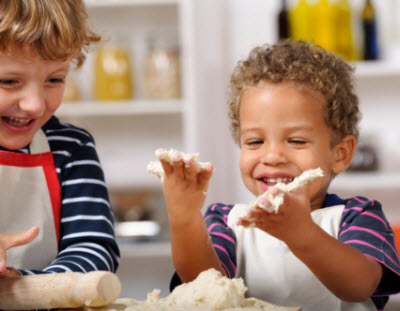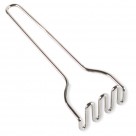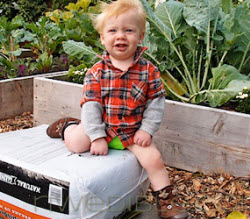 This is the first of a series. See also: Create a Kids’ Tasting Menu, Get Out and Explore and Get Into Ethnic Food.
This is the first of a series. See also: Create a Kids’ Tasting Menu, Get Out and Explore and Get Into Ethnic Food.
If you are anything like most parents, you have probably spent the preschool years on a culinary tour of Blandland, the place where the wonderful flavor and diversity of food go to die. Perhaps, like me, you have put on an extra 10 lbs. ingesting macaroni and cheese and pizza, or have silently fumed while your kid picked tiny bits of green onion or parsley out of a soup.
How did we get such “picky” kids? One theory is that small children instinctively prefer bland, familiar food so as to avoid getting poisoned (as they might have in the distant past). Some nutritionists think it’s related to eating too many snacks and processed foods laden with salt and sugar. Whatever the reason, many American kids shut down their taste buds from age two to six. This is all very frustrating, especially if you like to cook.
And of course eating a diverse diet with a variety of foods is directly related to their health. Our children need to eat protein, fruit, and vegetables to maintain a baseline of health. Fighting to get healthy food into them is discouraging and stressful.
The good news is that as kids grow older, you have a chance to press the mealtime restart button. And one of the best ways to do this is to involve kids in cooking meals. Involving them in cooking not only teaches them to enjoy preparing food, something they will do nearly every day of their future lives, but exposes them to fractions, basic math, chemistry, stove- and knife-related safety, gives them access to a wide variety of tools and teaches them how to follow detailed instructions. For really small children, cooking provides motor skill training. For example, simply cracking an egg involves fine motor skills, concentration, aim, and attention to detail.
Here are some specific ways to involve kids in meal preparation:
 1. Get child-size cooking utensils. It’s less frustrating for small hands if they have the proper sized tools. Whisks, mixing spoons, spatulas, peelers, and knives are good basics to buy. Planet Happy near University Village in Seattle has a line of kids’ cooking utensils. Or, they are easily bought online. Try to use mixing bowls that have handles or some kind of lip the child can hold onto. Similarly, light mixing cups with good handles are helpful. Invest in a solid, proper-size step stool to get your child to the right counter level. (We use an inexpensive, foldable one from the hardware store.)
1. Get child-size cooking utensils. It’s less frustrating for small hands if they have the proper sized tools. Whisks, mixing spoons, spatulas, peelers, and knives are good basics to buy. Planet Happy near University Village in Seattle has a line of kids’ cooking utensils. Or, they are easily bought online. Try to use mixing bowls that have handles or some kind of lip the child can hold onto. Similarly, light mixing cups with good handles are helpful. Invest in a solid, proper-size step stool to get your child to the right counter level. (We use an inexpensive, foldable one from the hardware store.)
2. Involve them in menu planning. By looking at recipes together, you introduce them to the concept of meal planning, but also feel them out for openness to new foods. One of my friends sits with her three children on Sunday afternoon each week and lets the oldest kid pick a few recipes (with her guided input) that the younger kids can then vote on. They generate a shopping list from the recipes and then she shops without them (for some alone time). The mom says it’s become a tradition for their family and made her life a lot easier. The kids are eating a bit better, but more importantly they are spending time together making food happen.
3. Take them shopping. I know this is a “button” for many parents, but when kids join you at the supermarket or farmer’s market they are exposed to new foods and see the time/effort that goes into shopping for food. Older kids can help load/unload groceries and scoop bulk foods. Supermarkets also feature samples, which are fun and can produce unexpected results (e.g., my fruit-averse daughter ate a piece of melon in our local market).
4. Pick simple recipes. Depending on your kid’s age and attention span, pick some recipes to try together that are relatively easy to make. Sweets like cookies, muffins, and cupcakes are fun to make, but also try healthier basics like scrambled eggs, pancakes, and oatmeal. Children enjoy using their hands, so include them when making pie crusts or assembling lasagna or gratins. Instead of relying on overly sweet and cutesy “kid” recipes, find dishes you both want to make and review the recipe for things the kids can do. The PCC site has great kid-friendly recipes. I also highly recommend Cynthia Lair’s cookbook, Feeding the Whole Family.
5. Get ready. Before you start, clear the counters and make sure you have a nice clean sink, cutting boards, knives, measuring cups, measuring spoons, dish towels, etc. Also double-check that you have all the ingredients. Get the kids to wash their hands and put on kid-size aprons or at least clothes that can get messy. (And then take a few deep breaths.)
6. Establish rules. Review the rules and the consequences of not following those rules at the beginning of the cooking process. Basic safety is a must, but also delineate how you want things to go. I was frustrated early on when my daughter kept eating the butter or grabbing things or impulsively pouring or stirring. Now I clearly state up front what I do and do not want to happen. The consequence of not following directions or rushing me is that she loses the privilege of licking the spoon and/or can no longer help. I stay calm and she knows what to expect. It’s now enjoyable to cook with her most of the time.
 7. Let them do the prep. Most kids enjoy playing with water so let them wash the fruits and veggies. For older kids, teach them proper knife handling skills with a child-friendly knife so they can prep veggies. (We use the Zyliss lettuce knife.) Or they can use a hand-powered food chopper. Younger kids can rip lettuce or kale leaves, or use a plastic lettuce knife to cut the tops off strawberries, cube tofu, or dice cucumbers. Few kids pass up a chance to run a machine, so get the Cuisinart out and let them push the buttons.
7. Let them do the prep. Most kids enjoy playing with water so let them wash the fruits and veggies. For older kids, teach them proper knife handling skills with a child-friendly knife so they can prep veggies. (We use the Zyliss lettuce knife.) Or they can use a hand-powered food chopper. Younger kids can rip lettuce or kale leaves, or use a plastic lettuce knife to cut the tops off strawberries, cube tofu, or dice cucumbers. Few kids pass up a chance to run a machine, so get the Cuisinart out and let them push the buttons.
8. Be realistic about their involvement. My four-year-old will beg me to let her help and then peel one carrot and leave; other times she’ll make an entire omelet with little intervention. Given your child’s age and interest level, you might not get 100 percent participation every time, so try to stay flexible. Try it again another time if it doesn’t work the first time. Accept that some kids will only do one thing (like run the coffee grinder) for a long time, but eventually they will get interested in doing more.
9. Accept the mess. It is unbelievably messy and time-consuming to cook with children. But keep in mind that you’re teaching them a really important life skill that is related to their future health.
10. Make it special. Set the table, go with the kids to cut flowers in the garden and put them in a vase, or make a centerpiece out of something fun (plastic dinosaurs, My Little Ponies, veggies, etc.), and sit down as a family to enjoy the fruits of your labor together. Celebrate the fact that your kid cooked!
 11. Take a cooking class with your kid. There are several options in the area. In greater Seattle, the PCC Kids Cook classes are very popular. You can also register for cooking classes through your local community center or check out Frog Legs Kids Culinary Academy in south Seattle, which offers classes, camps, and birthday parties. Mangia Bene Catering in North Seattle has a cooking school that offers private, after-school cooking classes for groups of six or more kids.
11. Take a cooking class with your kid. There are several options in the area. In greater Seattle, the PCC Kids Cook classes are very popular. You can also register for cooking classes through your local community center or check out Frog Legs Kids Culinary Academy in south Seattle, which offers classes, camps, and birthday parties. Mangia Bene Catering in North Seattle has a cooking school that offers private, after-school cooking classes for groups of six or more kids.
12. Involve them in gathering/picking/growing food. Showing your children how food is grown is an important and direct way to get them more interested in eating a variety of foods. It doesn't have to be extensive -- try planting one of these five vegetables to grow with kids. If you don't have a garden or a garden space, create a mini-garden in a pot or a window box, or grow some herbs and let your kids pick them. My daughter was very engaged in the process of tending the few tomato and bean plants we could squeeze into our small garden, and she learned to eat cherry tomatoes and raw green beans and peas. Even if you don’t grow food, look for chances to pick berries, apples, and pumpkins at local area farms
See also:
How to Grow an Adventurous Eater, Part 2: Create a Kids’ Tasting Menu
How to Grow an Adventurous Eater, Part 3: Get Out and Explore
How to Grow an Adventurous Eater, Part 4: Get Into Ethnic Food.
 About the author
About the author
Elise Gruber is a writer and project manager who grew up in Miami, where the eating of clams and conchs was considered normal. She loves to cook and think about food so is not enjoying the “beige food years” so much. In fact, she nearly burst into tears of joy when her kid yelled, “Mommy, I like beets now!” at the salad bar.
This article was originally published in October 2012 and updated in October 2013.









